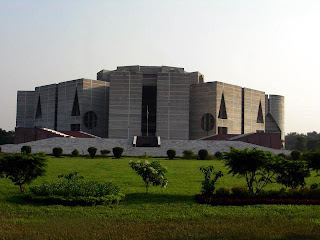Palestine flag
INTRODUCTION
Palestine is located in South-West Asia and is in the heart of the Middle East. To its north is Syria and Lebanon, to its south the Gulf of Aqaba and the Sinai Peninsula, and on its east is Jordan. Historic Palestine was once a land stretching from the Mediterranean coast east across the Jordan River, and from the Gulf of Aqaba north beyond the Sea of Galilee. Today this geographical area is divided into the state of Israel (established in May 1948), and the West Bank (including eastern Jerusalem) and the Gaza Strip which Israel occupied in 1967. The struggle between the Israelis and the Palestinians is one of the most enduring and explosive of all the world's conflicts with it roots in historic claim to the land.
Intifada is simply the defense of the Palestinian people against this oppression.
Intifada: انتفاضة Arabic word stands for shaking off or shivering because of fear or illness. It also means abrupt and sudden waking up from sleep or unconcerned status. Politically; The word came to symbolise the Palestinian uprising against the Israeli occupation. The word also stands for the weakness of the Palestinian people and their suffering under the Israeli occupation.
Intifada is simply the defense of the Palestinian people against this oppression.
The Gaza Strip was established at the end of the 1948 Arab-Israeli war. Its boundaries were defined by the ceasefire lines. It was placed under Egyptian rule and held in trust for a future Palestinian state.
At the end of the 1956 Suez-Sinai War, the Gaza Strip was occupied by Israel. A year later Israel withdrew its troops as a result of international pressure and a United Nations Emergency Force (UNEF) was placed in the Gaza Strip.
In June 1967, Israel recaptured the Gaza Strip during the Six-Day War. In November of the same year UN Security Council Resolution 242 called on Israel to withdraw from the Gaza Strip and other ‘occupied territories.
Gaza is an arid rectangle of territory at the southeast end of the Mediterranean. 45 km (25 miles) long and 10 km (6 miles) wide, it is wedged between Israel to the north and east, and Egypt’s Sinai Peninsula to the south. The Gaza Strip is one of the most densely populated places on earth with 3,823 persons per km2. The population of Gaza tripled in 1948-49 when it absorbed approximately 175,000 Palestinian refugees fleeing their homes in what is now Israel. There are now about 1.5 million inhabitants in the Gaza Strip. The majority of the population is young refugees: the average age in the Gaza Strip is 16.
INTRODUCTION
Palestine is located in South-West Asia and is in the heart of the Middle East. To its north is Syria and Lebanon, to its south the Gulf of Aqaba and the Sinai Peninsula, and on its east is Jordan. Historic Palestine was once a land stretching from the Mediterranean coast east across the Jordan River, and from the Gulf of Aqaba north beyond the Sea of Galilee. Today this geographical area is divided into the state of Israel (established in May 1948), and the West Bank (including eastern Jerusalem) and the Gaza Strip which Israel occupied in 1967. The struggle between the Israelis and the Palestinians is one of the most enduring and explosive of all the world's conflicts with it roots in historic claim to the land.
Palestinian tiger
Currently, the Palestinian people are being oppressed by Israel. This manifests itself in many ways; from the use of bullets and missiles against demonstrators; to the continued building of settlements with no respect for Palestinian rights; from the removal of Palestinians from their homes; to the continuos disregard for numerous United Nations resolutions.Intifada is simply the defense of the Palestinian people against this oppression.
Intifada: انتفاضة Arabic word stands for shaking off or shivering because of fear or illness. It also means abrupt and sudden waking up from sleep or unconcerned status. Politically; The word came to symbolise the Palestinian uprising against the Israeli occupation. The word also stands for the weakness of the Palestinian people and their suffering under the Israeli occupation.
Intifada is simply the defense of the Palestinian people against this oppression.
The Gaza Strip was established at the end of the 1948 Arab-Israeli war. Its boundaries were defined by the ceasefire lines. It was placed under Egyptian rule and held in trust for a future Palestinian state.
At the end of the 1956 Suez-Sinai War, the Gaza Strip was occupied by Israel. A year later Israel withdrew its troops as a result of international pressure and a United Nations Emergency Force (UNEF) was placed in the Gaza Strip.
In June 1967, Israel recaptured the Gaza Strip during the Six-Day War. In November of the same year UN Security Council Resolution 242 called on Israel to withdraw from the Gaza Strip and other ‘occupied territories.
Gaza is an arid rectangle of territory at the southeast end of the Mediterranean. 45 km (25 miles) long and 10 km (6 miles) wide, it is wedged between Israel to the north and east, and Egypt’s Sinai Peninsula to the south. The Gaza Strip is one of the most densely populated places on earth with 3,823 persons per km2. The population of Gaza tripled in 1948-49 when it absorbed approximately 175,000 Palestinian refugees fleeing their homes in what is now Israel. There are now about 1.5 million inhabitants in the Gaza Strip. The majority of the population is young refugees: the average age in the Gaza Strip is 16.
Palestinian children




















































